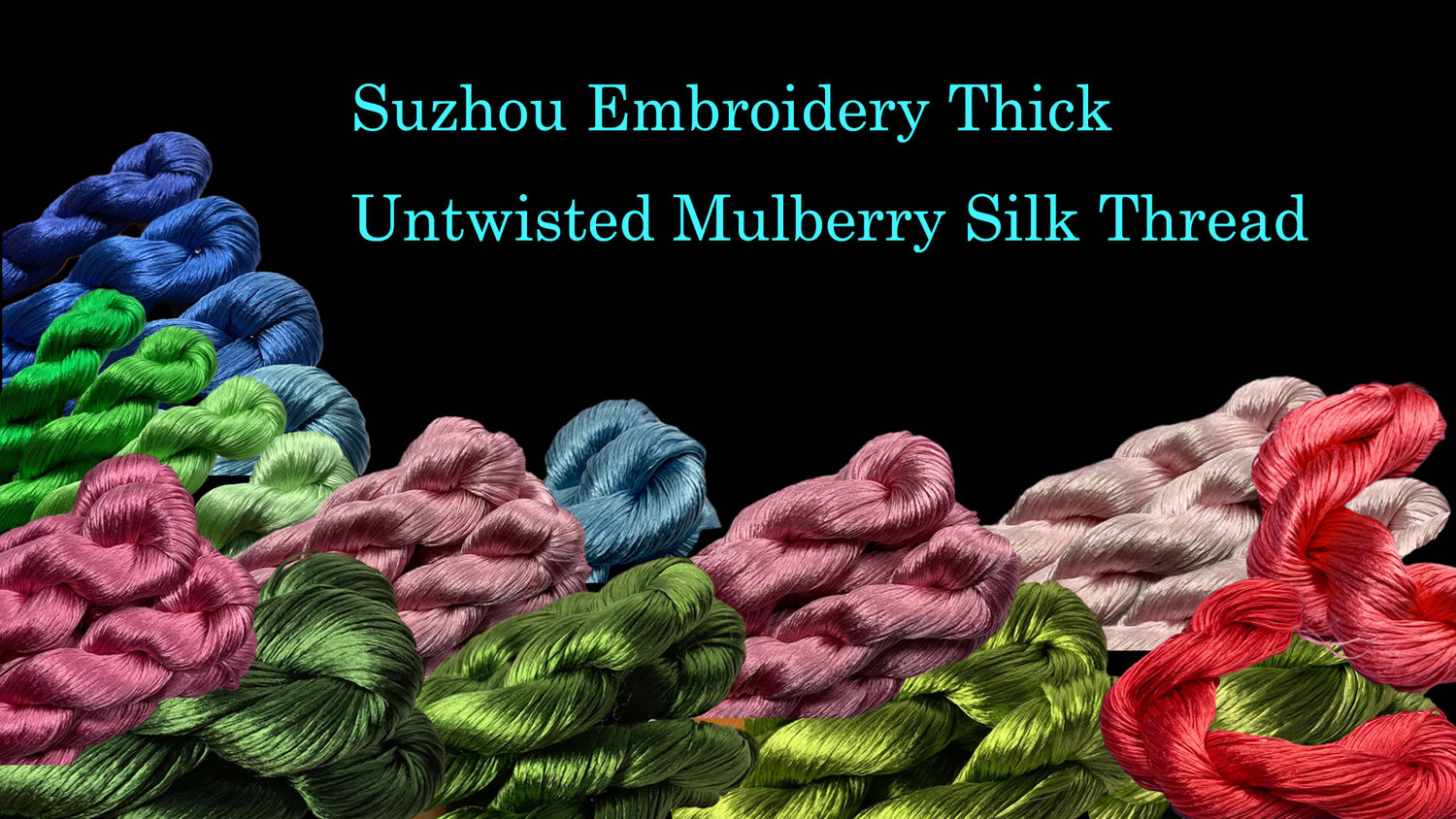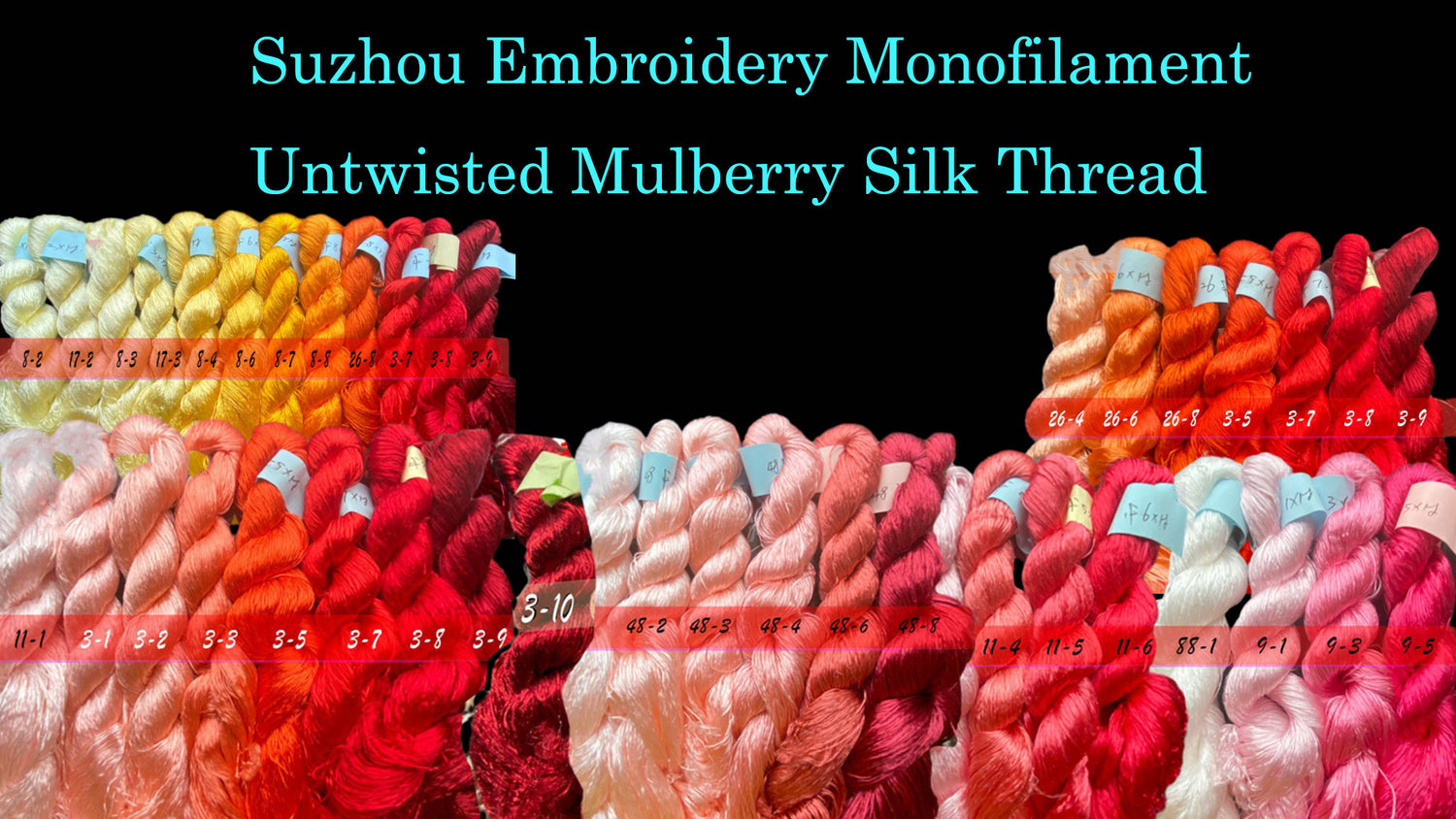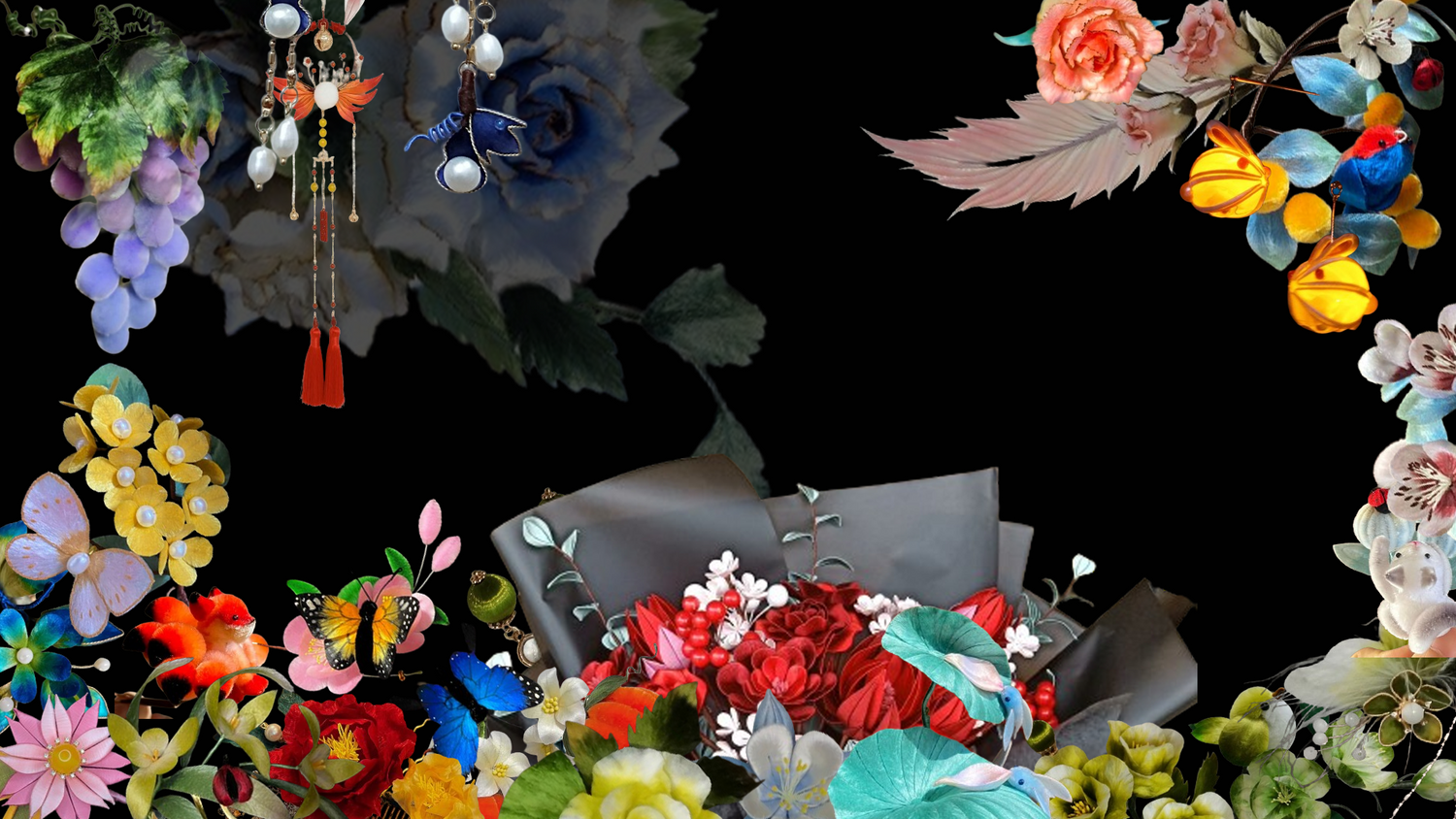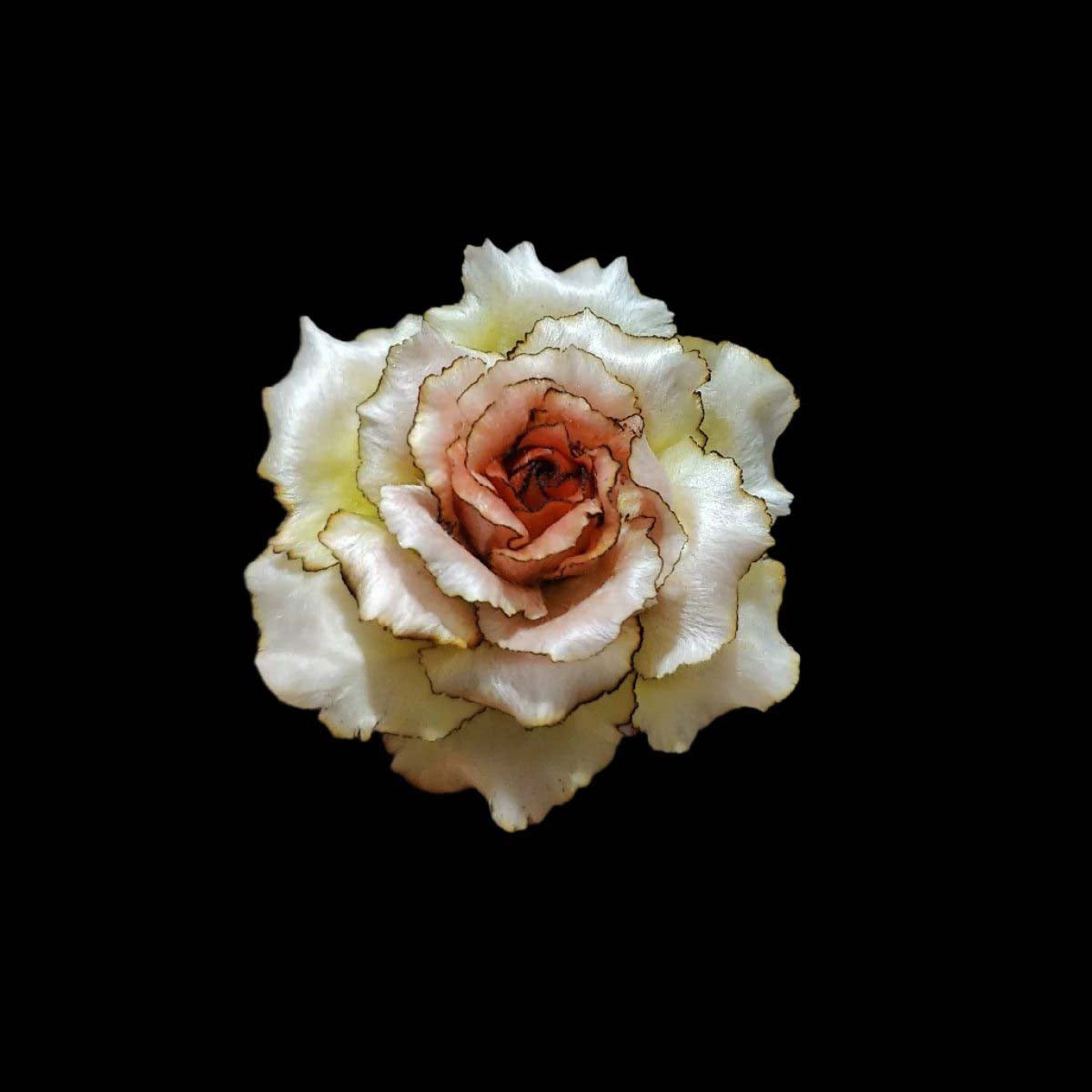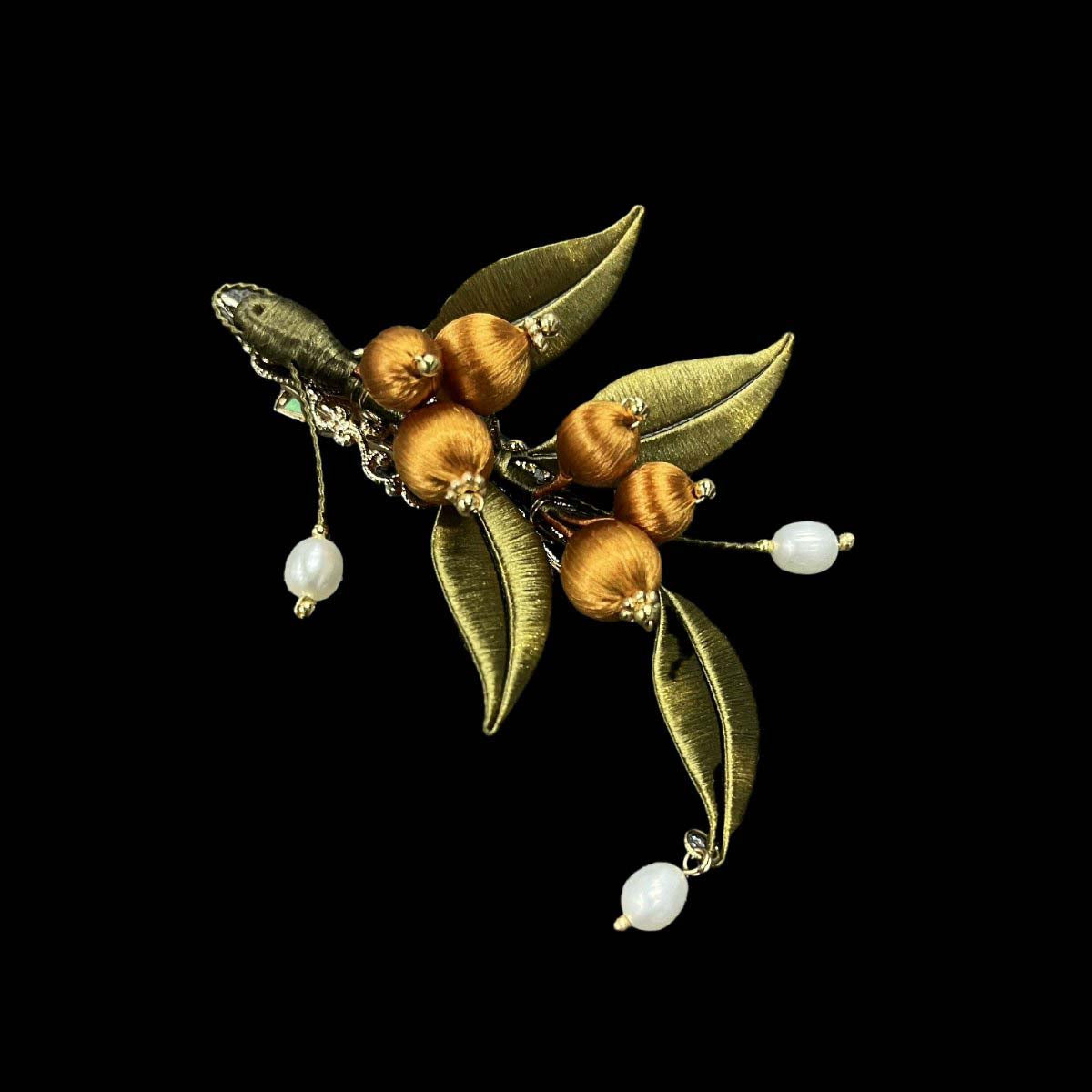
How to Make a Swallow Gold Flower Chanhua Round Fan
Share
6.1.1 Making the Long Chain of Gold Flowers
The long chain of gold flowers is a crucial part of this Chanhua piece. This section mainly explains the basic Chanhua starting techniques, the methods for creating each component of the long chain of gold flowers, and the simple assembly techniques for combining these components. It starts simple and progresses to more complex techniques, enabling readers to easily get started and master some basic Chanhua methods.
A. Materials and Tools:
No. 30 floral wire, White card paper, Carbon pen, Scissors, White glue, Decorative pearls, Silk threads in imperial yellow, pale white, light green, and French green, Pliers
B. Making the Stamen
 1 2
1 2
1. Take a piece of No. 30 floral wire (hereafter referred to as "wire") and bend one end, with the bend approximately 0.6 cm.
2. Fold the bent end of the wire back on itself repeatedly four times.
 3
3
3. Bend the wire perpendicular to the loop and wrap it tightly to form an oval-shaped stamen.
C. Making the Four-Petal Flower
 1 2
1 2
1. Use a carbon pen to draw the shapes of four petals on white card paper, ensuring the inner side of the petals is relatively narrow. After drawing, cut along the lines with scissors, dividing each petal in half to get 4 groups, totaling 8 pieces of card paper.
2. Take a wire of appropriate length (the wire length should be longer than the length of four petals, with some excess). Hold one end of the imperial yellow silk thread and one end of the wire with your left hand. With your right hand, wrap the silk thread around the wire clockwise from left to right for 1 cm.
 3 4
3 4
3. Press the previously wrapped silk thread with your left finger, and wrap the silk thread clockwise from right to left again with your right hand to complete the Chanhua starting operation.
4. Take a piece of card paper, align the narrow end with the starting end of the wire, place it on the wire, hold the card paper tightly with your left hand to fix it, and wrap the silk thread evenly around the card paper from right to left with your right hand to create a half petal.
 5
5
5. Take another piece of card paper, this time aligning the wider end of the petal with the half petal already wrapped. Ensure there is no gap in the middle. Wrap the silk thread around, bending the wire appropriately to make the two sides of the petal symmetrical and complete.
 6
6
6. Bring the left and right petals together, form a loop with the silk thread using your right hand, pass it through the entire petal, and tie a knot at the end. Repeat the knotting 2-3 times to secure it.
 7 8
7 8
7. Bend the wire and add new card paper at the bend, using the same method to make the second petal.
8. After wrapping all four petals, finish off and leave the remaining silk thread. Place the stamen inside the four petals, hold it tightly with your left hand, and adjust the overall layout of the petals with your right hand.
 9
9
9. Wrap the silk thread in circles on the back of the flower and tie it into a knot. Repeat multiple times to secure the petals and stamen firmly.
 10
10
10. Place a carbon pen under the petals, gently press the petals downward with your hand and the pen to create a certain arc, taking care not to force it to avoid breaking the petals.
D. Making the Receptacle
 1
1
1. Use a carbon pen to draw the shapes of five petals with equal width on both ends on card paper, and cut them out with scissors. Then cut each petal in half to get 5 groups, totaling 10 pieces of card paper.
Tip: These petals are used for the receptacle of the four-petal flower, so the diameter of the petals should be smaller.
 2
2
2. Take a wire and start wrapping one end with the pale green silk thread, referring to the starting method of the four-petal flower.
 3
3
3. Place a piece of cut half-petal card paper on the wire, and wrap the silk thread evenly around the card paper, adding another piece of card paper following the wrapping method of the four-petal flower petals to create a complete petal.
 4
4
4. Bend the wire into a symmetrical petal, and tie a knot at the end, repeating 2-3 times.
 5
5
5. After wrapping all five petals, take the previously made four-petal flower, place the five petals under the four-petal flower to form the receptacle. Adjust the shape of the receptacle to fit closely with the four-petal flower, and wrap the remaining thread around the wire of the four-petal flower and the receptacle, securing it with white glue at the end.
E. Making the Five-Petal Pearl Stamen Flower
 1
1
1. Draw five groups of petals based on the receptacle's template and cut them out.
 2 3
2 3
2. Take a wire, leaving some excess at one end, and start wrapping it with pale yellow silk thread. Complete the five petals using the same method as the receptacle.
3. Turn the wrapped five-petal flower over, with the wire side up and the card paper side down, making the flower outline more prominent, and adjust the position of the petals.
 4
4
4. Bend the starting end of the wire up between the petals, thread a decorative pearl through the wire as the stamen, then bend the wire down through the gap on the other side of the petals.
F. Making the Five-Petal Silk Thread Stamen Flower
 1
1
1. Follow the method in "Making the Five-Petal Pearl Stamen Flower" to create a five-petal flower.
2. Prepare a piece of French green silk thread, fold it in half, and loop it over one of the petals, with both ends of the silk thread facing downward.
 3 4
3 4
3. Pass both ends of the silk thread through the bottom of the flower, and loop them through the gap directly opposite the petal from step 1.
4. Wrap the silk thread in the direction indicated by the arrow, then pass it through the bottom of the flower and loop it out following the arrow direction again.
 5
5
5. Wrap the silk thread as indicated by the arrow.
6. Repeat the above method, wrapping the silk thread every two petals. The more times it is wrapped, the more prominent the stamen will be. After wrapping, secure the excess thread and wire together with white glue.
G. Making the Two-Tone Leaves
 1
1
1. Draw the shape of a long, thin leaf (the leaf does not need to be symmetrical, having different curvatures on each side appears more natural) on white card paper, cut it out with scissors, and cut the leaf in half. When wrapping the leaf, wrap leaf A from the inside out and leaf B from the outside in.
 2
2
2. Take a wire and start wrapping one end with French green silk thread, leaving enough excess at the end.
 3
3
3. Align leaf A with the edge of the wire and start wrapping tightly from the inner side with silk thread. Fix it with white glue at the end.
 4
4
4. Take a piece of pale white silk thread, start wrapping it again, align leaf B with the wire, and wrap it from the outside in.
 5
5
5. After wrapping the leaf, fold the wire in half to overlap the two halves of the leaf, and wrap the excess silk thread around the ends of the wire, securing it with pliers at the leaf's outer side.
Tip: For making single-color leaves, there is no need to change the thread. Use a single color silk thread to wrap.
H. Assembly
 1
1
1. Use pale green and French green silk threads to make several single-color and two-tone leaves. Arrange the leaves into groups and make several four-petal and five-petal flowers.
 2
2
2. Wrap pale green silk thread around the wire at the end of the leaf, then take another leaf and wrap its wire together with silk thread, choosing the position to add leaves as needed.
 3
3
3. While assembling the leaves, you can add flowers, wrapping them with silk thread to form a chain of flowers. Adjust the direction of the flowers, leaves, and stems as needed to make the chain more attractive.
 4
4
4. After completing the chain of flowers, wrap and tie the end with silk thread, securing it with white glue if necessary.
6.1.2 Making Short Golden Flower Strands
Creating short golden flower strands involves adjusting the shapes of the flowers and leaves based on the long strands and adding buds and leaves in various forms. This section focuses on extending and combining Chanhua shapes using the techniques from the previous section.
A. Materials and Tools:
30-gauge wire for silk flower crafts, White cardstock, Carbon pen, Scissors, Imperial yellow, pale white, light green, and emerald green silk threads, White glue, Decorative pearls, Pliers
B. Making and Assembling Basic Components
The methods for making stamens, four-petal flowers, flower receptacles, five-petal flowers with pearl stamens, five-petal flowers with silk thread stamens, and multicolored leaves have been described earlier. Use these methods to prepare the following:
 1 2
1 2
1. Make three multicolored leaves and six monochrome leaves, with varying shapes and sizes for a natural look. Group leaves into three sets of three and wrap them together, ensuring a balanced distribution.
2. Make three four-petal flowers and eight five-petal flowers (three with larger petals, five with smaller petals). Four-petal flowers should have receptacles and stamens; five-petal flowers can have pearl or silk thread stamens.
 3 4
3 4
3. Draw and cut cardstock for making buds and leaves, ensuring the overall size is smaller for the receptacle.
4. Make four four-petal flowers, folding the petals upward to form buds. Separately wrap several leaves and combine them into sets of two and three leaves.
 5
5
5. Combine the buds and leaves.
 6
6
6. Take one four-petal flower and combine it with "one large, two small" five-petal flowers and a leaf to create a branch of the golden flower strand.
 7
7
7. Combine the prepared bud with a four-petal flower, "one large, one small" five-petal flowers, and a leaf. Add another four-petal flower, a large five-petal flower, and a large leaf to complete the branch.
 8
8
8. Combine the two flower branches, adding remaining five-petal flowers and leaves at the junction to complete the short golden flower strand.
6.1.3 Making the Swallow
After completing the two golden flower strands, the next step is to make the swallow. The materials and methods are detailed below.
A. Materials and Tools:
White cardstock, Carbon pen, Scissors, 30-gauge wire for silk flower crafts, White glue, Decorative small pearls, Dark gray and light gray silk threads, Pliers, Alcohol glue
B.Making the Swallow Wings
 1 2
1 2
1. Draw the swallow's outline on white cardstock with a carbon pen and cut out six pieces.
2. Distinguish the inner and outer sides of the swallow wings. The wide end connected to the body is the inner side, and the slender tail end is the outer side.
 3
3
3. Start a wire with dark silk thread, add a piece of wing cardstock from the inner side, and wrap tightly. Add another piece of cardstock at the end and wrap from the outer side to complete the second piece.
 4 5
4 5
4. Fold and clamp the wire with pliers, wrap the thread to the end, and secure with white glue.
5. Repeat for the other wing.
C. Making the Swallow's Body 1
1
1. Take a 20 cm long wire and fold it in half, pressing firmly to create a crease and combining the wires. Start with dark silk threads at the crease, tightly wrapping the upper half of the swallow's tail to the root.
 2
2
2. Take another 20 cm long wire and repeat the previous step to complete the wrapping of the lower half of the swallow's tail. When you reach the tail root, wrap the silk threads around the upper half of the tail to make the two halves of the tail fit together. Begin wrapping the body according to the shape of the cardstock. After wrapping about 5 mm of the body, leave two of the four wires at the back of the cardstock exposed and no longer wrap them with the body.
 3
3
3. When you reach the head, separate the remaining two wires. One wire is used to attach the cardstock of the swallow's belly, and the other is used to add decorative pearls.
 4 5
4 5
4. Start with light-colored silk threads at the position of the swallow's beak, adding another piece of body cardstock, and complete the wrapping of the body along the wire.
5. Fold the wire to combine the body, merging the folded wire with the previously exposed wire ends, and secure with silk threads by tying knots.
 6
6
6. Thread several pearls onto the wire left at the swallow's head for decoration, adjusting their position to cover the seam of the body. Fold and secure the wire with knots.
 7
7
7. Tie and secure the wires of the swallow's wings and body, combining them together. To prevent the wings from moving side to side, apply alcohol glue at the connection between the wings and body.
 8
8
8. Use the extra silk threads to attach the swallow to the branch of the long golden flower strand. Then combine the short golden flower strand with the long one to complete the flower strand. Bend the wire ends and finish by wrapping.
 Finished Product Display
Finished Product Display

